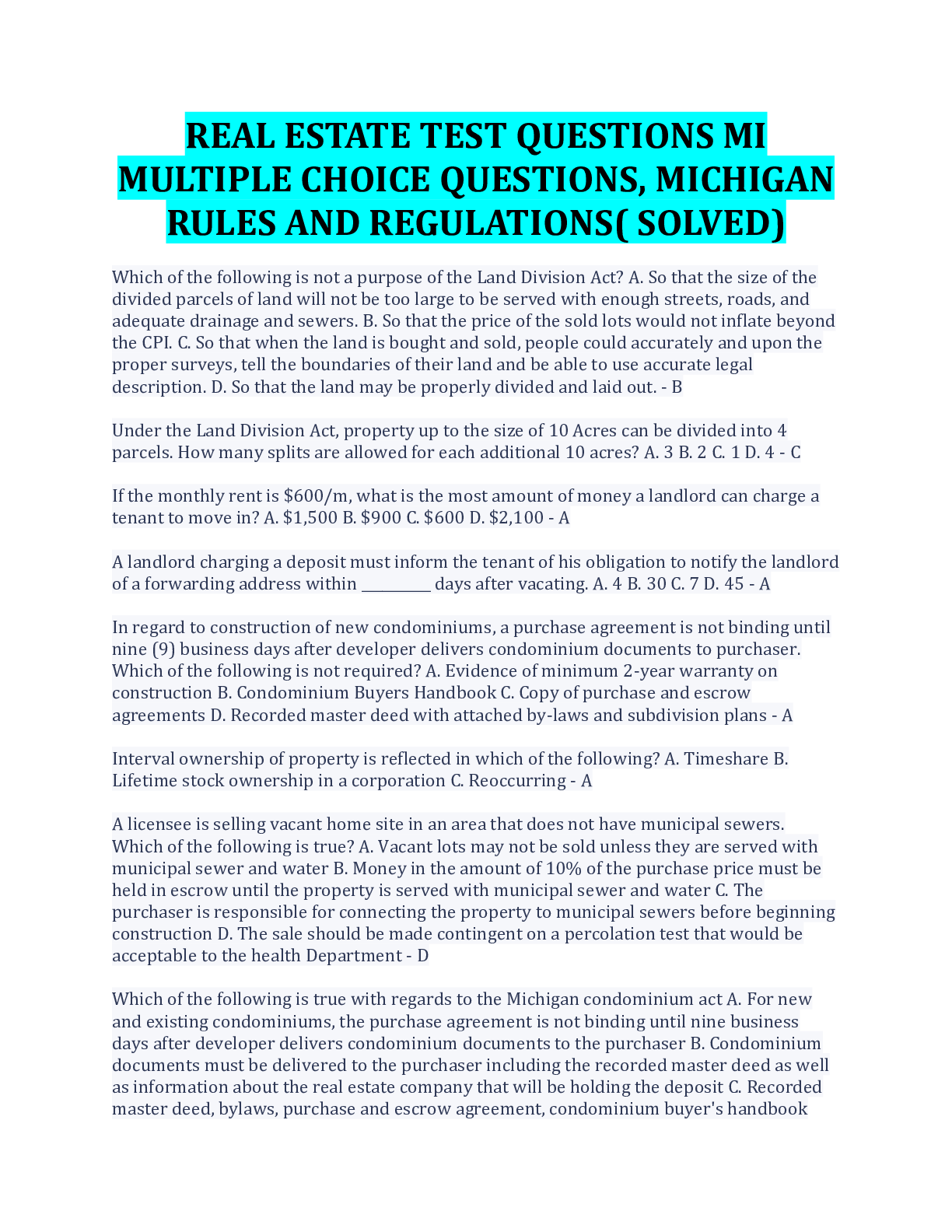History > EXAM > Western Civilizations Study Set 1/ Quiz 7: Romes Three Heirs, 500-950. Includes 50 Multiple Choice Q (All)
Western Civilizations Study Set 1/ Quiz 7: Romes Three Heirs, 500-950. Includes 50 Multiple Choice Questions, 15 true or False and 10 Essay Questions and Answers. 100% Exam-Correct Information.
Document Content and Description Below
Western Civilizations Study Set 1/ Quiz 7: Romes Three Heirs, 500-950 1. Justinian's longest lasting reform was the: A)creation of a standing Roman army. B)organization and codification of Roman l... aw. C)construction of the Coliseum. D)adoption of Christianity. E)publication of a series of books about Roman history. 2. Why did Justinian try to reconquer the Western Roman Empire? A)Because the Persians had been defeated in the East,so he could safely launch military expeditions to the West. B)Because his empire required continuing conquests in order to prosper. C)Because he sought to revive and reconstruct wholly the old empire. D)Because he needed to keep his army as far away from his capital as possible. E)Because he believed that he should be the head of a unified Christian Church. 3. Why did Justinian's reconquest of the Western Roman Empire fail? A)Justinian codified Roman law,which made a permanent merger impossible. B)Western Christians no longer felt kinship with eastern Christians,and they fought against Justinian from within. C)The costs associated with conquering and defending the vast western empire were too great given Justinian's military commitments elsewhere. D)Constantinople fell to Persian invaders and brought an end to the Eastern Roman Empire. E)Justinian was forced to withdraw his army to meet the mounting Islamic threat from the south. 4. Justinian's Corpus would influence later rulers by becoming the foundation of: A)Nazism. B)Communism. C)absolute monarchy. D)constitutional monarchy. E)democracy. 5. Between 610 and 1071,the major security threats to the Byzantine Empire came from: A)Persia,then Egypt. B)Persia,then the Islamic caliphate. C)Persia,then the Turks. D)Persia,then the Slavs. E)the Western Roman Empire. 6. The stability of Byzantine government was the product of: A)a highly centralized palace government. B)a predictable system of succession to the imperial throne. C)an efficient bureaucracy. D)regulated wages and prices. E)a ruthlessly effective army. 7. The Byzantine economy in the early Middle Ages was: A)highly regulated,including wage and price controls. B)subject to wild fluctuations due to currency debasement. C)industrially underdeveloped. D)renowned for its use of paper money. E)depressed due to being cut off from trade with northern Europe. 8. The Iconoclastic Controversy of the eighth century c.e.was about: A)the biblical laws forbidding "the work of Satan" on Sundays. B)Emperor Leo's decision to stop wearing the toga,the symbol of imperial manhood. C)the impossibility of smashing all the pagan idols,so some were allowed to remain. D) The use or prohibition of images in church,where people might worship the objects. E)prohibition of the display of the crucifix in Byzantine churches. 9. Leo III's support of iconoclasm may have been driven by a desire to: A)make churches more beautiful. B)strengthen the emperor's control over the Church at the expense of monastic control. C)strengthen monastic control over the Church at the expense of the bureaucratic control. D)encourage artisans to produce books rather than images. E)encourage Orthodox Christians to follow some of the tenets of Islam. 10. Although the Iconoclastic Controversy was eventually resolved,its lasting effects included the: A) sale or handing over of Byzantine portraits to the Muslims. B) destruction of nearly all pre-eighth-century religious art in the Byzantine empire. C)adoption of conservative clothing styles by nobles and common people. D)gradual acceptance of religious diversity in the East. E)banning of all monastic orders within the Byzantine empire. 11. During the reign of Leo III,many Byzantine monasteries were suppressed because: A)they questioned the emperor's authority. B)they produced icons. C)they questioned the divinity of Jesus. D)they incorporated Muslim theology. E)they denied the existence of an afterlife. 12. The architecture of the Hagia Sophia was intended to: A)honour the achievements of the emperor. B) celebrate the Roman Empire. C) Symbolize the mysteries of the Christian faith. D) Honor the revelations of Muhammad. E) celebrate the multiculturalism of Constantinople. 13. The word Islam means: A)pilgrimage. B)migration. C)submission. D)recitation. E)prayer. 14. Where did Islam emerge? A)Arabia B)Egypt C)Palestine D)Anatolia E)India 15. By the late sixth century c.e. ,the economy of Arabia was: A)in a state of crisis brought on by the wars between Byzantium and Persia. B)commercially sophisticated and was intersected by many trade routes. C)still almost entirely made up of nomadic Bedouins. D)based on the production of figs,wool,and goats at desert oases. E)practically nonexistent due to Arabia's domination by the Byzantine empire. 16. In Mecca,Muhammad gained few converts to Islam because: A)citizens of Mecca saw his monotheism as a threat to the significance of the Kaaba. B)the large number of Christians in Mecca viewed Muhammad as a false prophet. C)people of other faiths disagreed with the practice of having multiple wives. D)as a young man,Muhammad committed numerous crimes. E)the large number of Jews in Mecca refused to worship another god. 17. In their worship of Allah,Muslims worship: A)the Prophet Muhammad. B)the angel Gabriel. C)the same deity worshiped by Christians and Jews. D)a pantheon of gods. E)the same deities worshiped by Hindus. 18. Following the Battle of the Trench: A)Jews in Medina were executed for treason. B)Christians in Medina were executed for treason. C)every Muslim in Medina was slaughtered. D)the entire city of Mecca was destroyed by Jewish forces. E)Muhammad fled Arabia. 19. The Qur'an contains: A)the revelations sent by God to Muhammad. B)Christian teaching about Christ's divinity. C)excerpts from the Hebrew Torah. D)a detailed plan for the expansion of Islam after Muhammad's death. E)the sole guide for behavior for converts to Islam. 20. According to the Muslim faith,the only way to achieve salvation is to: A)worship Muhammad. B)worship Jesus. C)respect the prophets of the Jewish,Christian,and Muslim faiths. D)observe the Five Pillars of Islam. E)observe the Ten Commandments. 21. Islam spread so quickly in the seventh and eighth centuries because: A)Muslims insisted that all conquered peoples convert to Islam. B)there were no Christians in the first lands that Muslims conquered. C)the Pact of Unmark allowed for the total destruction of subject cities. D)some local populations welcomed Muslim conquest. E)its armies met no resistance. 22. During the expansion of the Islamic caliphate,Muslim rule was often preferred to Persian or Byzantine because: A)Muslim laws were less strict. B)the caliphate extracted fewer taxes from conquered populations than these empires. C)local Muslim rulers were considered better protectors than the governors from other empires. D)Muslim rulers were believed to be more moral than Byzantine and Persian emperors. E)Muslim rulers were regarded as better military leaders. 23. The Shiite party arose among Muslims because: A)disputes between Muslims in Iran created a schism. B)of a dispute about the proper succession of caliphs in seventh-century Arabia. C)the Umayyad dynasty wanted to expand westward. D)the Abbasid dynasty wanted to expand eastward. E)of a dispute in the eighth century regarding the proper interpretation of the Qur'an. 24. In comparison to the Umayyad,the Abbasid caliphate: A)was more like a Byzantine successor state. B)adopted more of the style of Persian royal absolutism. C)moved its capital from Baghdad to Damascus. D)modeled itself on the imperial court of Rome. E)required all conquered peoples to convert to Islam. 25. The Umayyads of Al-Andalus and the Abbasids of Persia competed for dominance through: A)constant violent warfare. B)a cold war,occasionally interrupted by brief proxy wars over disputed territories. C)the constant creation and negotiation of alliances. D)trying to surpass each other in support of literary and artistic production. E)trying to conquer as much territory as possible. 26. The Shiite claim to legitimacy rests on the direct connection to Muhammad through his daughter: A)Aisha. B)Yasmina. C)Fatimah. D)Khadijah. E)Sawda. 27. Within Islam,social mobility was encouraged because of: A)a decree by the Umayyad dynasty outlawing discrimination of all kinds. B)the teachings of the twelfth imam that everyone should be tolerant of everyone else. C)the origins of the faith where no one could take advantage of anyone else. D)the teachings of Muhammad,which stressed the equality of all Muslim men. E)a decree of the Abbasid dynasty outlawing discrimination of all kinds. 28. Both the Persians and the Arabs learned to make paper from the: A)Egyptians. B)Chinese. C)Anatolians. D)Carthaginians. E)Romans. 28. Both the Persians and the Arabs learned to make paper from the: A)Egyptians. B)Chinese. C)Anatolians. D)Carthaginians. E)Romans. 29. Although Muslim culture offered few opportunities for women as religious leaders, one exception was ________,who was a wife of Muhammad and a scholar. A)Fatima B)Aisha C)Khadija D)Arsinoe E)Hera 30. Opportunity for advancement in Islamic cultures ideally depended on: A)the social class into which one was born. B)the sect of Islam that one professed. C) One's ability and one's talent. D)the level of bribes one was able to offer. E)whom one knew within the bureaucracy. 31. Charlemagne and Harun al-Rashid formed an alliance partially because of their shared enemy, the: A)Umayyad. B)Persians. C)Byzantines. D)Sunnis. E)Abbasid. 32. Intellectuals in the court of Charlemagne hoped to create: A)a revival of the culture of Rome. B)a revival of the culture of Greece. C)a revival of the culture of Egypt. D)more cooperation between Muslim and Christian scholars. E)a school to train Christian theologians. 33. Most people in the early Middle Ages facilitated economic transactions by using: A)standardized silver coins minted by a local lord. B)standardized gold coins minted by the king. C)jewels and gems. D)food and labor. E)manufactured goods. 34. The power of lords often depended on which of the following? A)The degree to which their followers saw them as godly men. B)Their ability to bestow gifts on their followers. C)Their education. D)Their success in converting their subjects to Christianity. E)Their ability to rule peacefully. 35. The Merovingian dynasty in France traced its origin back to Clovis's legendary grandfather,Merovech,who was believed to be: A)the last commander of the Roman legions in the West. B)the son of a sea monster. C)the grandfather of England's King Arthur. D)a Benedictine monk who converted the Franks. E)a Viking who had settled in northern France and conquered the Lombards. 36. Monasteries in the early Middle Ages were: A)places of economic import only. B)founded in cities. C)places of political,religious,and economic import. D)places of religious import only. E)places of political import only. 37. One of the major sources of the wealth of the Merovingian family was its: A)colleges. B)traders. C)monasteries. D)banks. E)large estates. 38. By roughly 750,the population of northern Europe began to expand.This was due,in part,to: A)longer growing seasons and a larger supply of food. B)the absence of warfare. C)migration from Asia. D)migration from the Middle East. E)laws which required couples to have large families. 39. Why were so many convents (monastic houses for women)founded during the seventh century c.e.? A)Convents met a variety of social and spiritual needs for women of all classes. B)Lower-class women flocked to convents as an improvement on the drudgery of their lives. C)Nuns were the only women allowed to become priests. D)Convents were a way for the families that founded them to make money. E)Families were expected to give their daughters to local monasteries to become nuns. 40. As a theologian,Pope Gregory I is regarded as the successor to: A)Francis of Assisi. B)John Chrysostom. C)Arius of Alexandria. D)Athanasius. E)Augustine. 41. A long-term result of Boniface anointing Pepin on behalf of the papacy was that: A)members of the Carolingian family regularly became popes. B)the Carolingians founded a new capital for their empire in Rome. C)first-born sons of the king henceforth became king automatically on the death of their father. D)the pope became directly responsible for the welfare of the Carolingian empire. E)the power of kings was theoretically limited. 42. Charles Martel gained power and prestige following his defeat of Muslim forces at the battle of: A)Orleans. B)Avignon. C)Tours. D)Marseilles. E)Verdun. 43. As a Christian king responsible for ruling a Christian society, Charle magne: A)was careful to observe the distinctions between religious and political authority established by Saint Augustine of Hippo. B)placed the Frankish church under the control of the pope,while he ruled the kingdom politically. C) took responsibility for reforming the religious life of his kingdom just as he reformed its government. D)became a monk at the end of his life,thus ensuring his own salvation. E)established his empire as a theocratic state ruled by the laws set forth in the Bible. 44. Underlying the Carolingian Renaissance was the basic conviction that: A)learning was the foundation on which Christian wisdom rested. B)the Bible could be best appreciated if it were translated into robust French and German idioms. C)original Latin poetry and epic literature were the highest form of art. D)proper Christian doctrine should be widely disseminated and heretical beliefs should be strictly punished. E)to be better Christians,everyone should pray and devote their lives to the Church. 45. Which was the most significant event in creating Byzantine hostility toward the Latin Christian world? A) The coronation of Charlemagne as Roman emperor on Christmas Day,800 B)The First Crusade C)The Iconoclastic Controversy D)The Fourth Crusade in 1204 E)The execution of the Byzantine ambassador to Rome in 816 46. The Vikings are generally regarded as being a destructive force in European history: A)but such a view may not be correct in light of the principalities they established across northern Europe. B)as evidenced by the raids they staged on virtually every population center in Europe from London to Paris to Rome itself. C)because of the destruction caused to many great monasteries throughout Europe and the accompanying loss of the libraries in those monasteries. D)but this has been exaggerated since they stayed mostly in Scandinavia with only a few raids into England and northern France,destructive though those were. E)which is true,but they have an undeservedly bad reputation when compared with the Magyars who conducted raids into western and southern Europe. 47. Once they conquered a territory,Viking populations: A)killed or enslaved all of the native population. B)assimilated quickly within local populations. C)divided the land into farms for Viking settlers,regardless of who was living and using that land. D)founded churches dedicated to Saint Amand,the patron saint of Vikings. E)elected a king to rule the area. 48. One of the few rulers to successfully defend his lands against the Vikings was: A)Alfred. B)Arthur. C)Bede. D)Charles. E)Thomas. 49. The Abbasid Empire effectively came to an end in: A) 1258, when the invading Mongol armies captured the Abbasid capital of Baghdad. B) 733, when the Abbasid Army was defeated by Charles Martel at Tours. C) 1066, when the dominant Shiites defeated the Sunnis at Damascus. D) 930, when the Shiites Army attacked and captured Mecca. E) 1186, when Philip of France and Richard of England captured Jerusalem. 50. The pandemic known as Justinian's plague spread rapidly through the eastern and western part of the Roman Empire because it: A) Was a very virulent strain of smallpox. B) Was carried by birds who migrated great distances. C) Travelled along well-established trade routes both within and outside the empire. D) had a very long incubation period, which meant people could travel long distances without knowing they were infecting people. E)was exacerbated by an epidemic of influenza in the empire. 51. The Byzantine Empire was never stable because of the intrigue and violence that constantly occurred at the imperial court. 52. Byzantine culture was the means by which the heritage of Western civilization was preserved for the Europe where Greek had become very rare. 53. Muhammad wrote about his revelations in the Qur'an. 54. Following the death of Muhammad,his daughter,Fatima,became the first caliph. 55. Following the death of Muhammad,his daughter,Fatima,became the first caliph. 56. As Islam spread, Ethiopia became the only remaining independent Christian kingdom in North Africa. 57. After 750 c.e. ,the Umayyad dynasty abandoned Spain and focused its rule in Damascus. 58. Spain was largely abandoned by Islam as a cultural backwater. 59. Islam created its own culture and actively destroyed the artifacts of those civilizations that came before them. 60. In Islamic society, the ulama was an especially learned man who had a thorough knowledge of religious law. 61. The Frankish ruler Gregory of Tours ruled in opposition to Roman models. 62. By the seventh century, Western Europe had become a more fluid economy in which luxury goods and coinage circulated, albeit to differing degrees, among all levels of society. 63. The Frankish dynasty could be traced back to Charlemagne. 64. Pope Gregory was not only a reformer of the Church and theologian, but was the first pope to break free of Byzantine control and establish an autonomous, Western-oriented Latin church. 65. Charles Martel is regarded as one of the founders of the Frankish kingdom due to his defeat of a Muslim force near Paris. Essay Questions and Answers 66. Explain how Justinian's conquest of the Mediterranean was both a success and a failure. 67. What factors allowed the Byzantine Empire to survive into the Middle Ages? 68. How can Muhammad be described as both a prophet and a statesman? 69. What effect did the death of Muhammad have on Islam? 70. What accounts for the rapid growth of Islam? 71. Why was paper such an important commodity in the Muslim world of the Middle Ages? 72. How did monasticism aid the growth and prosperity of secular empires? 73. What was the legacy of the Carolingians? 74. What innovations characterize the Carolingian Renaissance? 75. What impact did Viking invasions have on Europe? [Show More]
Last updated: 2 years ago
Preview 1 out of 21 pages

Buy this document to get the full access instantly
Instant Download Access after purchase
Buy NowInstant download
We Accept:

Reviews( 0 )
$13.00
Can't find what you want? Try our AI powered Search
Document information
Connected school, study & course
About the document
Uploaded On
Nov 24, 2020
Number of pages
21
Written in
Additional information
This document has been written for:
Uploaded
Nov 24, 2020
Downloads
0
Views
160

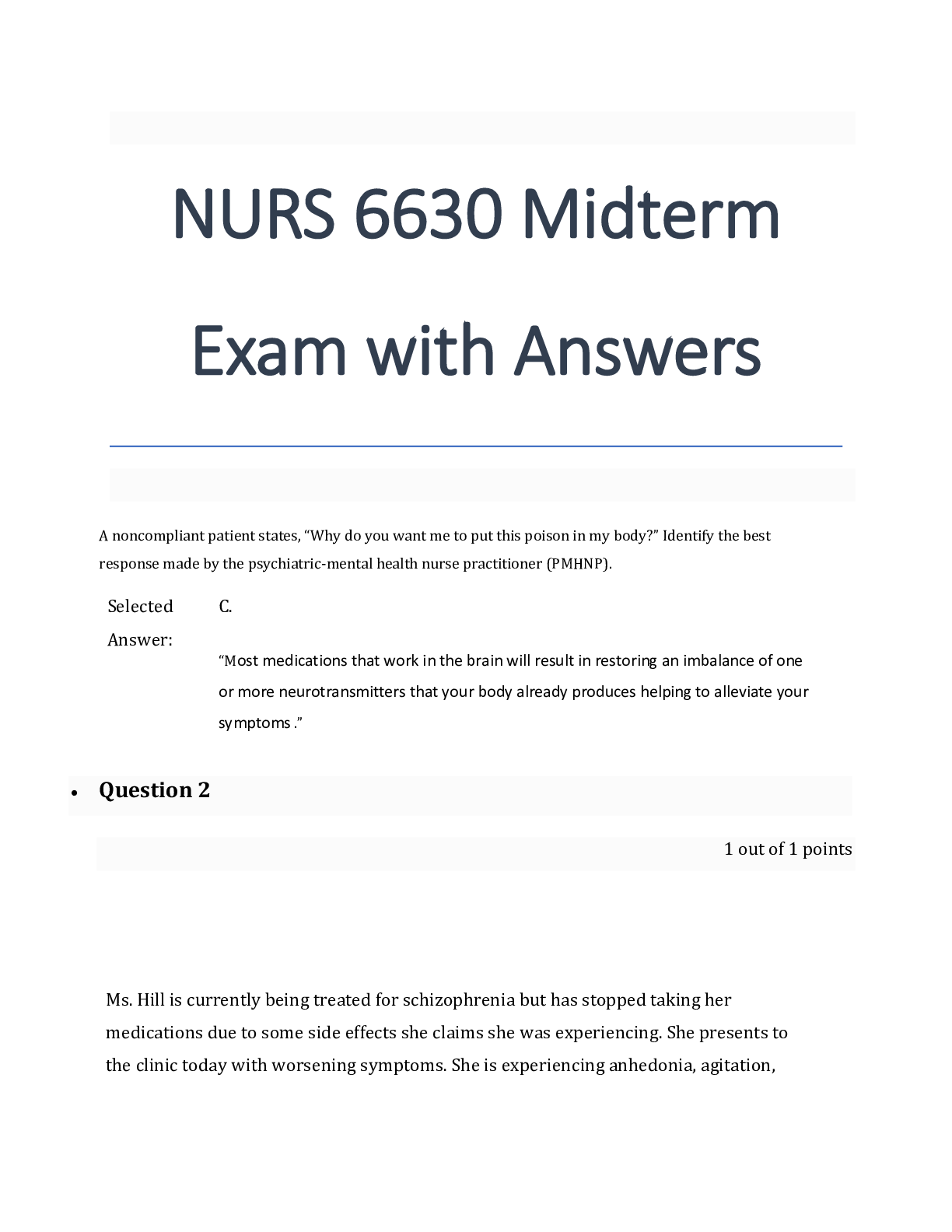

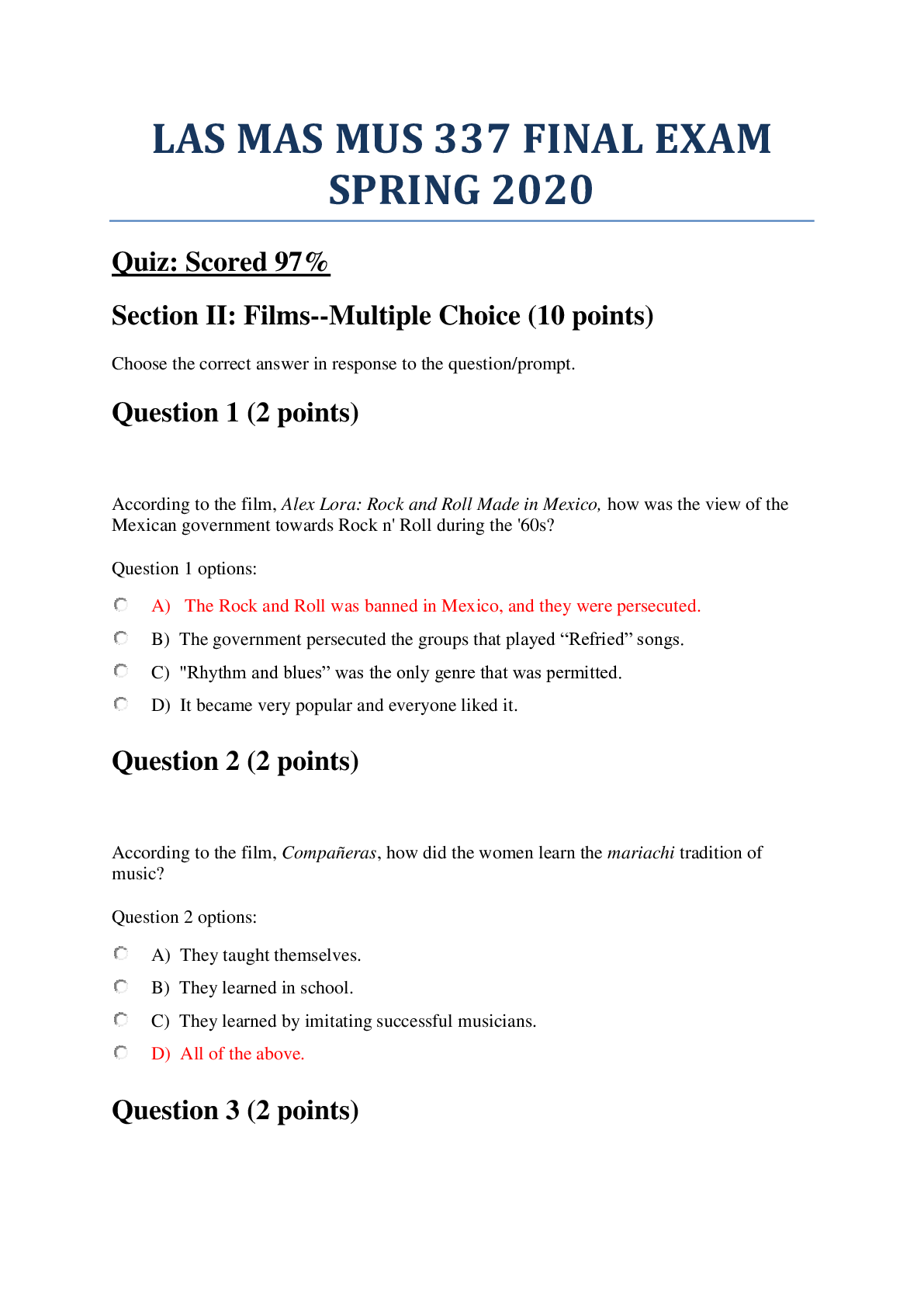




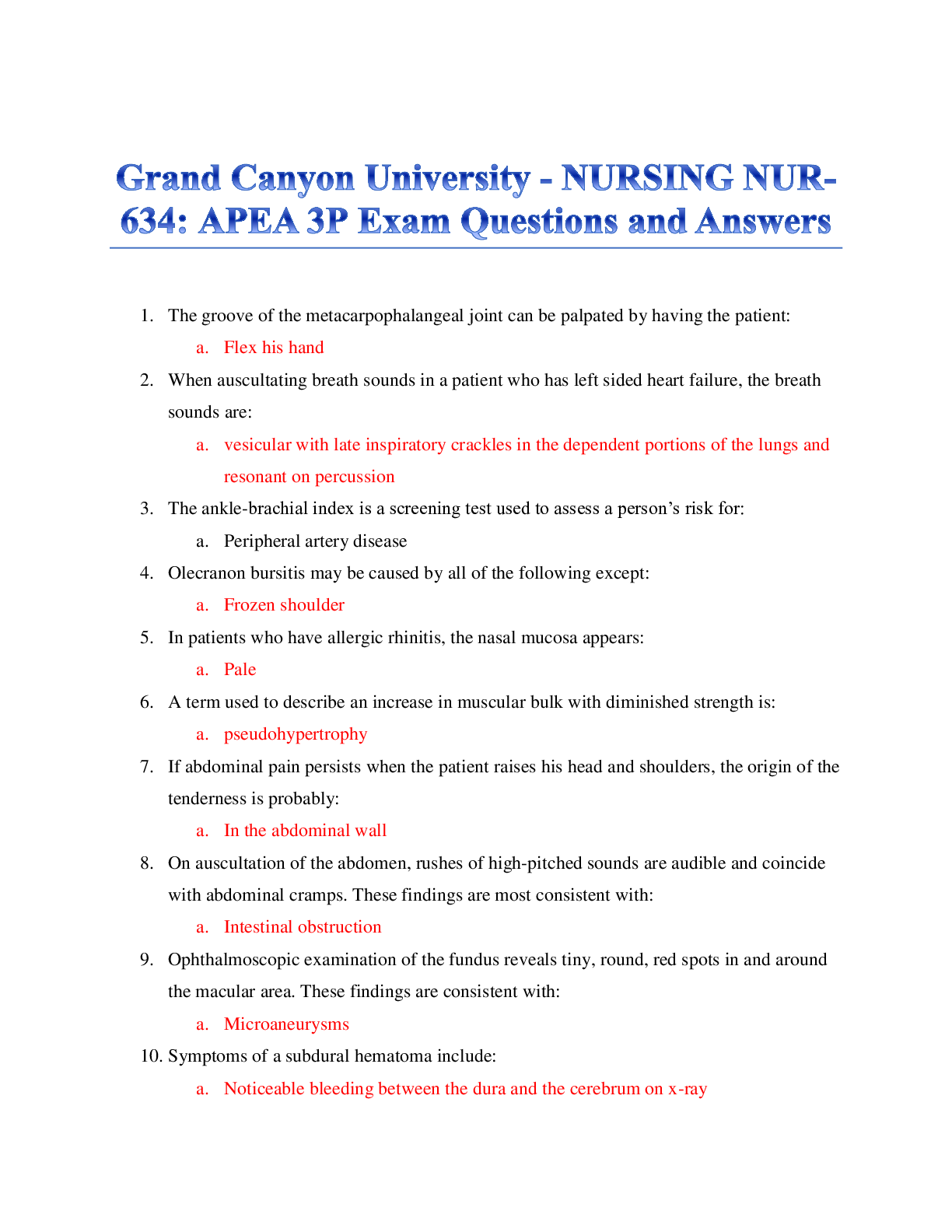
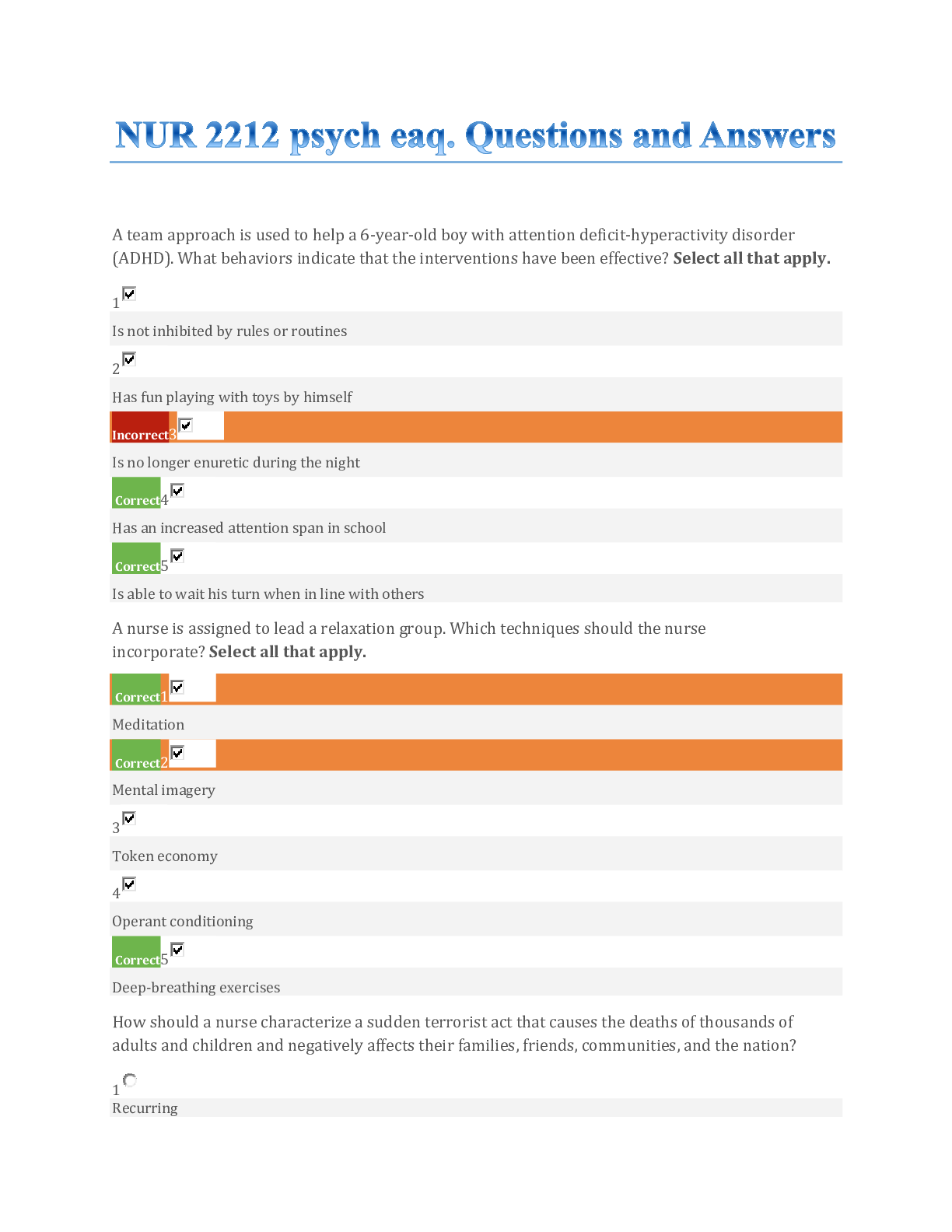









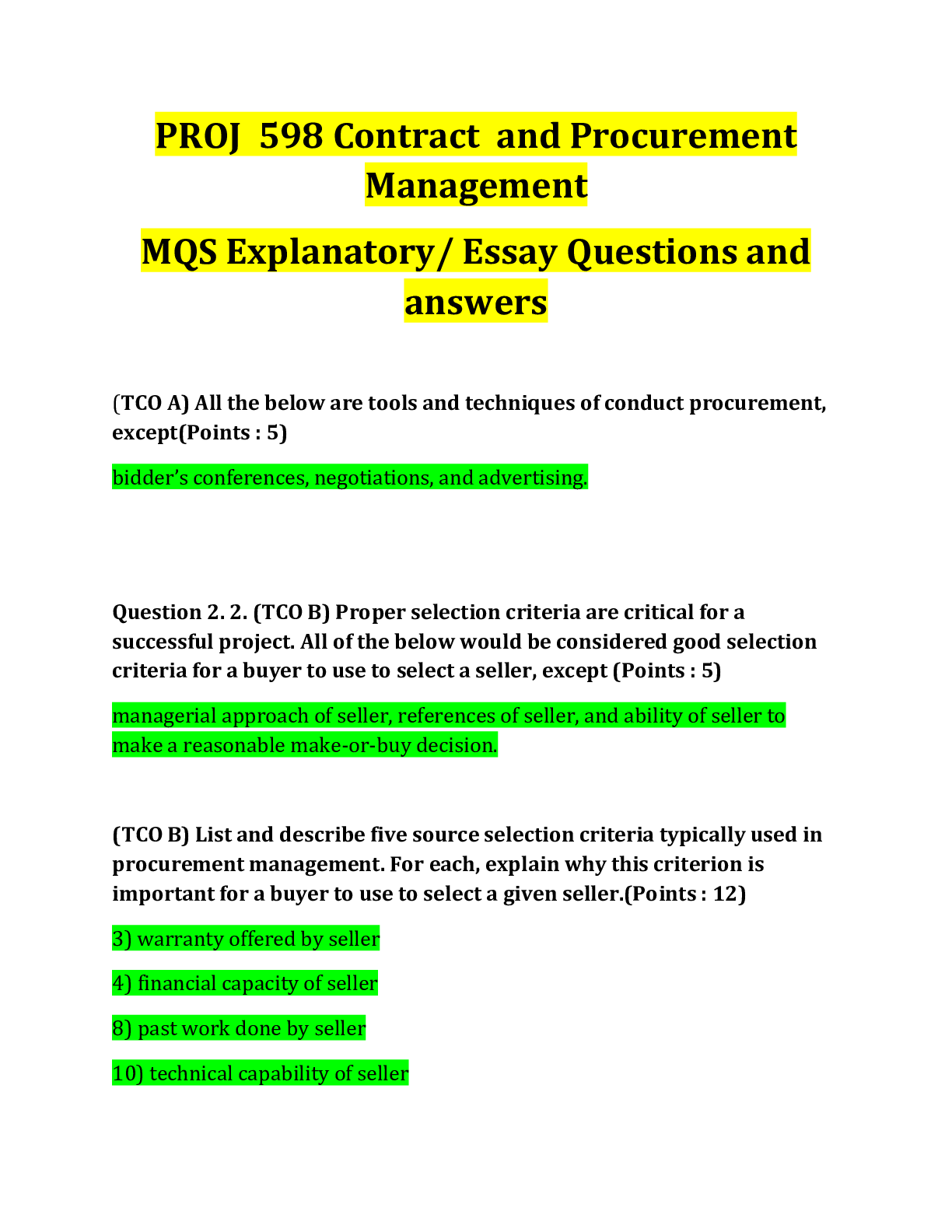
.png)
